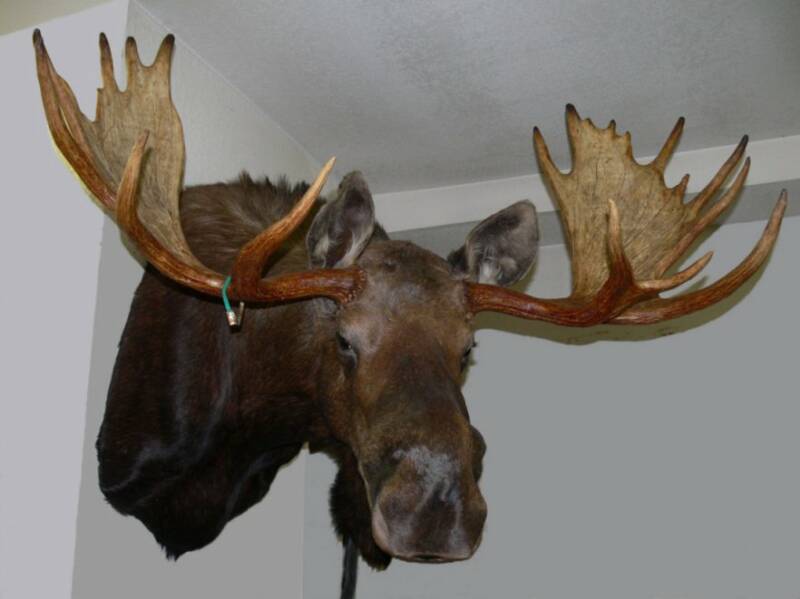© 1998 Backcountry Taxidermy - All Rights Reserved
Website Design by MCH Outdoor Web Design
All too often, taxidermists are handed damaged goods. Taxidermists see hunters making the same mistakes skinning and caring for the hide of the animal, mistakes that noticeably affect the quality of the final product.
Taxidermist
Tips For Better Trophies
"You spend money to go on a hunt that you may never do again and you get a trophy - it just takes a little research to make a big difference," said Dan Lewis with Backcountry Taxidermy in Anchorage. " We get so much work in that could have been better if they just would've known - how to make the cuts, to salt it - and we want them to know."
Taxidermy has come a long way in the past decade. Better materials and improved techniques enable taxidermists to create much more lifelike and realistic mounts. Many taxidermists are talented artists, but none are magicians.
Skinning
If a hunter is back in town after just a day or two in the field, they can bring their trophy in and the taxidermist will skin it. Birds can be carefully wrapped and frozen to preserve them before delivery.
Hunters in the field for any length of time need to skin their game. If a hide isn't removed and properly cared for, the hair slips. Caping or skinning an animal properly involves some technique, but it's fairly straightforward. A few tips make a big difference.
"I think most taxidermists would appreciate that hunters in the field know the initial skinning diagram," said Dan. Much of Dan's work is on bears. "Often they don't know where to begin, they corkscrew the legs, go up the middle of the leg, and turn a normal-looking bear into a two-foot-wide bear that's nine-feet long."
There is a one-page bulletin, "Skinning Bear," which details proper skinning techniques. It also diagrams the important and tricky face and paw cuts. It's available at http://www.adfg.alaska.gov/index.cfm?adfg=blackbearhunting.skinning
Most taxidermists can provide skinning diagrams and advice for hunters, and will happily answer questions about specific animals.
Dan says when hunters are caping out an animal for the classic shoulder mount, they often don't leave enough hide for the taxidermist to work with.
"Consider mid-body to be the circumference cut," he said. "People usually go right back behind the shoulders, and we need a few more inches, about six to eight more inches, to work with. That also opens up a variety of mounts."
The best advice for skinning is to use a small knife. Some taxidermists use utility knives to skin animals, which enables them to quickly replace dull blades rather than taking time to sharpen knives.
A smaller knife is better, especially once you get up in the facial area. A small, sharp knife with a three to four inch flexible blade. Like a paring knife, or a small kitchen knife.
"I do everything with a four-inch little knife," Dan said. "You have better control, you can get into the tight spots and it holds the edge, unlike a big wide hunting knife."
Control is especially important when skinning around the head and face any game animal.
"You've got to stay really close to the skull," Dan said. "You don't want cuts on the face. The hair is short on the face and it's mostly skin. Cuts can show. There are some accidents you just can't hide."
The ear should be cut off right at skull. The eyes are same way - we need as much eyelid as possible, lips, and nose - cut off right at the skull. The more skin the taxidermist has to work with the easier his job is, and the better quality the mount."
With bears, it's important to skin the paws down to the last digits and cut them so the claws remain with the skin. It's also important to pull the short tail bone out of the tail.
Care of the skin
Once the skin is off, it's important to remove excess fat and tissue. This is easy to do at first and very difficult to do later. With spring bears, a thin layer of meat adheres to the skin on the flanks and underbelly, which can be peeled off right after the animal is skinned.
Another tip is to split the lips, cutting from the inside, which creates another inch of material for the taxidermist to work with. That's used to anchor the mouth to the form, (the plastic "skull" and material that goes inside the mount) and is especially important for open-mouthed mounts. The lips of most trophies are thin. Care must be taken when splitting them to avoid cutting holes in the delicate tissue.
Any blood should be rinsed off the trophy. Blood attracts bacteria, and bacterial activity will cause the fur and hair to slip and fall out.
The next step is critical - salting the hide. Salt draws the moisture out of hides and tightens up the hair follicles. This is particularly critical on the face, where hair is thin and any hair loss is particularly noticeable. Liberally salt the skin side of the hide, packing salt inside the ears, around the nose, on the split lips and on the fur side of the muzzle as well.
Dan recommends using 20 pounds of salt on an average black bear hide and twice that on an average brown bear. Salt the feet and between the toes as well, and get salt down into the tail.
Never store or transport a hide in a plastic bag, or wrapped in plastic. Instead, always store a hide in a burlap or game bag, in a cool, dry place out of the sun. Hanging the bag allows the hide to drain and dry.
"The best thing is to get the hide out of the field and into a freezer," Dan said. "Most air services have freezers and will put hides in them for clients if they can just get the hides out of the field."
What to expect from the taxidermist
It can take between nine and 18 months to get a finished product back from a taxidermist. There are several reasons for the wait. Taxidermy work tends to be seasonal: Two years ago Dan received 16 brown and black bears in just a couple weeks in May.
Dan and other taxidermists depend on professional, commercial tanneries to tan the hides.
Tanning is another whole business. It takes too much time and space to do both - it takes a big shop to do tanning."
A lot of the tanneries and taxidermists get pretty overloaded in summer. A lot of tanneries have three-month turn around, and a taxidermist needs at least another month after they get back the tanned fur."
Follow these tips and you will have a trophy to be envied for years to come.
Dan Lewis (907) 980 - 6423
 | ||||


